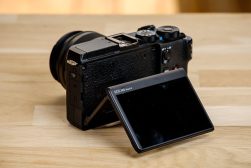
Canon 6D vs 7D | Popular DSLR Camera Comparison
Deciding between the Canon 6D vs 7D? This guide is for you! Find out which one is best suited to your photography needs and budget in 2024.
If you’re struggling to decide on your next camera, then you’ve come to the right place: this Canon 6D vs 7D guide will tell you everything you need to know.
Now, the Canon 6D and the Canon 7D are both great DSLR cameras.
But they’re also very different – because they’re designed for very different purposes.

With a 20 MP full-frame sensor, the Canon 6D nails beautiful shots – regardless of what genre you're shooting.
The Canon EOS 6D is perfect for photographers looking for their first full-frame DSLR. It offers great image quality, a relatively compact build, and a bargain price.
Whereas the Canon EOS 7D is a specialized piece of kit, featuring a rugged, professional-type body and fast continuous shooting speeds.
Let’s take a closer look at both of these cameras.
Canon 6D vs 7D | Key Differences
1. Size, Weight, and Build
The Canon 6D and the Canon 7D are two very different animals, and this becomes clear the moment you hold them both in your hands.
Despite its larger sensor, the Canon 6D is a relatively compact, lightweight camera. It clocks in at around 770 g (27 oz), with a 148 x 111 x 74mm body.
And while the 6D’s body feels well-built, and does come with weather sealing, it’s pretty plasticky overall.
The Canon 7D, on the other hand, feels like a beast. While it doesn’t weigh significantly more than the 6D (860g/30 oz), and it isn’t significantly bigger (148 x 111 x 74mm), its body is made of magnesium alloy, offering a level of durability that the 6D can’t match.
I’ve used both these cameras extensively, in both good and bad weather. My 7D has handled a lot and has come through without a hitch or a scratch.
But while my 6D is still working well, I always hesitate before subjecting it to adverse weather.
Note that this durability also translates to mechanical shutter life; while the 6D is rated at a decent 100,000 actuations, Canon promises 150,000 actuations on the 7D.
In other words, the Canon EOS 6D is an enthusiast camera. It’s good for travelers who want the full-frame sensor but aren’t looking for top-of-the-line build quality.
The Canon EOS 7D, meanwhile, is built like a tank, meant for photographers who will be subjecting it to rain, sea spray, mist, and more. In this section of the Canon 7D vs 6D face-off, there is one clear winner.
2. Image Quality

Canon 6D | Credit: Mark Condon
At the time of release, both the Canon EOS 6D and 7D offered competitive image quality for their respective target audience.
But these days, the 6D and 7D are older cameras. The Canon 7D came out way back in 2009, while the 6D isn’t much newer; it debuted in 2012.
So neither camera will give you class-leading image quality. For that, you’ll want to look at more recent options, such as the Canon 6D Mark II, the Canon 7D Mark II, and more.
That said, when pitting these two cameras against one another, you’re going to notice some significant performance differences.
First, the Canon EOS 7D is an APS-C camera with an 18 MP sensor.
So while you’ll get decent resolution, even by today’s standards, you’re just not going to see the same high-ISO performance you can expect from a full-frame camera like the 6D.
And real-life tests bear that out. The full frame 6D packs a 20 MP full-frame sensor, and while its image quality is a step down from Canon’s leading full-frame bodies, it’s far from bad.
You’ll start to notice some noise around ISO 3200, with images becoming unusable by ISO 12800 or so (though you might be able to get away with such high ISOs if you’re a street photographer or you work in black and white).
Compare this to the Canon EOS 7D, which begins to show noise in the ISO 400-800 range, before becoming unusable at around ISO 3200.
This translates to around two stops of high ISO improvement on the 6D versus the 7D, which can be critical for anyone looking to capture low-light images – such as event photographers, astrophotographers, and more.
Interestingly, both cameras are pretty comparable when it comes to dynamic range, offering around 12 stops (though the Canon 6D edges out the 7D by a hair).
Canon has pushed its latest cameras firmly into the 13-14 stop territory, with competitors like Nikon and Sony a stop beyond that. So if dynamic range is important to you, I’d recommend going for a different option entirely.
(If you’ve got the budget and are keen to use a full frame camera, check out our comparison of Canon 6D vs 5D Mark III.)
3. Autofocus and Drive (FPS)
If the Canon EOS 6D stands out in terms of image quality, then the Canon EOS 7D shines in its autofocus and continuous shooting capabilities.
While the 6D was designed for photographers who wanted affordable full-frame image quality, the 7D was designed for photographers who prize speed over all else.
That’s why you get 19 cross-type autofocus points on the 7D, which was quite fast for the time – compared to 11 points (and just one cross-type point) on the 6D.
In practical terms, this means that the Canon 7D focuses more quickly and offers better AF coverage, which is necessary when shooting erratic subjects, such as birds, wildlife, and sports players.
Not that the 6D’s autofocus is bad: when using one-shot AF, it’s perfectly fast, and the camera only starts to struggle when trying to continuously focus around the periphery of the frame.
As with image quality, you should be aware that AF capabilities have advanced greatly in recent years. This means that a camera like the Canon 90D, part of a lineup that would technically be considered a half-step below the 7D, offers 45 AF points, all cross-type.
The Canon EOS 7D also soundly beats the 6D when it comes to continuous shooting speeds. You can shoot 8 frames-per-second on the 7D, compared to 4.5 frames-per-second on the 6D.
Bottom line: If you’re in need of a camera for sports photography, action photography, or wildlife photography of any kind, the Canon 7D will serve you much better than the 6D.
For this Canon EOS 6D vs Canon EOS 7D specs comparison, the Canon 7D emerges on top.
4. Viewfinder and LCD
One of the ways you can tell the difference between a professional (or semi-professional) DSLR model and an enthusiast DSLR model is by looking at the viewfinder.
Professional cameras, like the Canon EOS 7D, offer full coverage of the scene.
This is critical for nailing your compositions in-camera, as well as ensuring you avoid distracting elements creeping in at the edge of the frame.
The Canon EOS 6D, on the other hand, features 97% coverage, which is better than beginner DSLRs, but not perfect.
Note that the Canon 7D also offers 1.0x viewfinder magnification, for a large, clear view of the scene – whereas the Canon 6D only includes 0.71x magnification.
As for the LCDs, they’re both 3” and pretty comparable in terms of resolution (1040k dots on the 6D, 920k dots on the 7D).
Unfortunately, neither offers touch capabilities, so if you’re used to using a smartphone or a recent interchangeable lens camera, you may find yourself struggling.
Neither screen is articulating or tilting, either, so you’re going to have a tough time vlogging with both of these bodies. In this Canon 7D vs Canon 6D battle, the Canon 7D has a clear advantage.
5. Connectivity & Battery Life
As I mentioned previously, the Canon 7D came out in 2009 – which explains why it has absolutely no connectivity options to speak of.
No wifi, no Bluetooth, nothing.
The Canon 6D, on the other hand, debuted just as connectivity technology made its way into DSLRs.
In fact, the Canon 6D was the first DSLR to feature wifi connectivity, offering the possibility of interfacing with a smartphone or computer.
So with the 6D, you can transfer images between camera and device.
You can also control your 6D via a smartphone or tablet, which is especially useful for capturing group photos (with you in them), though it can also be used for landscape photography, still life photography, creative wildlife photography, and more.
As for battery life, it’s slightly better on the 6D as well. According to Canon, shooting with the viewfinder will give you 1090 shots with the 6D, while battery life on the 7D is limited to 800 shots when using the viewfinder.
The Canon 7D does slightly outperform the 6D on battery life while using live view (279 shots to the 6D’s 220 shots) but that’s only really a benefit if you intend to spend a lot of time shooting with live view switched on.
6. Video
The Canon 7D and the Canon 6D have identical video specs on paper:
Full HD (1080p) shooting at up to 30 frames per second, with the option to shoot at 60 frames per second with a reduction in quality (down to 720p).
In other words, neither of these cameras are great video performers – not with modern-day competitors offering 4K/30p and 4K/60p recording capabilities.
But if you want to play around with some basic video shooting, you’ll do just fine with either option.
Note that the Canon 6D does have one benefit over the 7D for video:
The full-frame sensor allows for greater control over depth of field. You’ll be able to capture smooth, creamy background bokeh at wide apertures – and while this is also possible with a crop-sensor camera like the 7D, it’s harder to pull off and requires faster glass.
7. Crop Factor and Sensor Size
Before you buy either of these cameras, you’re going to want to ask yourself: What focal length do I need the most?
And if you’re a wide-angle shooter, then the 6D is going to be far-and-away the better option.
The 7D, on the other hand, is a better choice for photographers who need extra reach.
See, with the APS-C 7D, you’re going to see your lens’s field of view reduced by 1.6x.
So a 100mm lens will offer a 160mm field of view.
And a 400mm lens will offer a 640mm field of view.
This is wonderful if you’re a wildlife or sports photographer, desperate for all the reach you can get.
But it’s a big problem if you like to shoot sweeping landscapes, because your 16-35mm lens suddenly becomes a 25-56mm equivalent.
Which is not at all ideal for the type of landscapes most professionals shoot.
That’s where the full-frame 6D is a better option – and is one of the main reasons why professional landscape photographers nearly all shoot full-frame.
Note that the smaller sensor on the Canon 7D also affects your images in one other key way: It produces a deeper depth of field than a full-frame sensor at equivalent apertures.
So if you’re a portrait photographer who loves that shallow depth of field look, you’re going to have an easier time achieving it on a full-frame body such as the Canon 6D.
8. Price
The Canon 7D and the Canon 6D are DSLRs that were discontinued by the manufacturer long ago.
In fact, both cameras have seen replacements:
The Canon 6D Mark II, in the case of the 6D.
And the 7D Mark II, in the case of the 7D.
So neither the Canon 6D nor the Canon 7D can be purchased brand new from Canon, these days.
That said, you can buy both of these cameras on the used market.
The Canon 6D currently goes for around US$500-600, which is a steal, considering that it gets you full-frame image quality, a relatively compact body, and a great shooting experience.
Whereas the Canon 7D is even cheaper: just US$200-300.
Is the 6D worth the doubled price?
That depends on your needs as a shooter. If you’re looking for decent high-ISO performance, I’d pay the extra sum and grab the 6D.
But if a full-frame sensor isn’t important to you, then the 7D is probably a better buy.
One thing to bear in mind is that, with the market’s steady shift to mirrorless, you can easily grab either of these DSLR cameras and several pro-grade lenses for under $1500.
Cool, right?
Canon 6D vs 7D| Final Words

Canon 6D | Credit: Mark Condon
Here’s the thing about the Canon 6D vs 7D:
In some ways, they’re quite similar.
Both are older cameras that have seen upgrades.
Neither offers top-of-the-line autofocus or image quality – for APS-C cameras or full-frame cameras.
Both are available for bargain prices, though the 6D is around $200-300 more.
But in other ways, the cameras couldn’t be more different.
Because while the 6D is built for hobbyists and enthusiasts wanting to upgrade to full-frame image quality (as well as a backup body for professional landscape and wedding photographers), the Canon 7D is designed for photographers who need a camera they can depend on, no matter the conditions.
The 7D has 8 fps continuous shooting, which is still impressive, 11 years after the camera was released.
The 7D also offers good autofocus coverage, an excellent shutter life, and top-of-the-line build quality.
If those features matter to you, then the Canon EOS 7D is the way to go.
Whereas the Canon EOS 6D gives you nice full-frame image quality in a compact body, as well as wireless connectivity.
The choice is up to you, but you can capture beautiful images with either of these DSLR cameras!

With a 20 MP full-frame sensor, the Canon 6D nails beautiful shots – regardless of what genre you're shooting.













